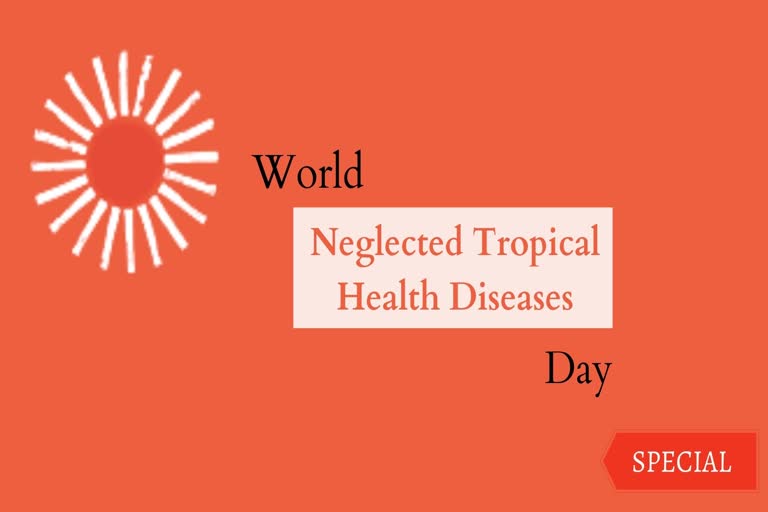The World health Organization (WHO) states 'NTDs affect over 1 billion people globally and cause pain and disability, creating lasting health, social and economic consequences for individuals and societies. They prevent children from going to school and adults from going to work, trapping communities in cycles of poverty and inequity. People affected by disabilities and impairments caused by NTDs often experience stigma within their communities, hindering their access to needed care and leading to social isolation'. Some of the NTDs are:
- Buruli Ulcer
A debilitating mycobacterial skin infection causing severe destruction of the skin, bone and soft tissue. - Chagas Disease
A life-threatening illness transmitted to humans through contact with vector insects (triatomine bugs), ingestion of contaminated food, infected blood transfusions, congenital transmission, organ transplantation or laboratory accidents. - Dengue
A mosquito-borne infection causing flu-like illness that may develop into severe dengue and cause lethal complications. - Dracunculiasis (Guinea Worm Disease)
A nematode infection transmitted exclusively by drinking-water contaminated with parasite-infected water fleas. - Echinococcosis
Infection caused by the larval stages of tapeworms forming pathogenic cysts in humans and transmitted when ingesting eggs most commonly shed in faces of dogs and wild animals. - Human African Trypanosomiasis ( Sleeping Sickness)
A parasitic infection spread by the bites of tsetse flies that is almost 100% fatal without prompt diagnosis and treatment to prevent the parasites invading the central nervous system. - Leishmaniasis
Disease transmitted through the bites of infected female sandflies that in its most severe (visceral) form attacks the internal organs and in its most prevalent (cutaneous) form causes face ulcers, disfiguring scars and disability. - Leprosy (Hansen’s Disease)
A complex disease caused by infection mainly of the skin, peripheral nerves, mucosa of the upper respiratory tract and eyes. - Lymphatic Filariasis
Infection transmitted by mosquitoes causing abnormal enlargement of limbs and genitals from adult worms inhabiting and reproducing in the lymphatic system. - Mycetoma
A chronic, progressively destructive inflammatory skin disease which usually affects the lower limbs. Infection is thought to be caused by the inoculation, through a thorn prick or skin damage, of fungi or bacteria into the subcutaneous tissue. - Onchocerciasis (river blindness)
Infection transmitted by the bite of infected blackflies causing severe itching and eye lesions as the adult worm produces larvae and leading to visual impairment and permanent blindness. - Rabies
A preventable viral disease transmitted to humans through the bites of infected dogs that is invariably fatal once symptoms develop. - Schistosomiasis
Trematode infections transmitted when larval forms released by freshwater snails penetrate human skin during contact with infested water. - Soil-transmitted Helminths (STH)
Nematode infections transmitted through soil contaminated by human faeces causing anaemia, vitamin A deficiency, stunted growth, malnutrition, intestinal obstruction and impaired development. - Trachoma
A chlamydial infection transmitted through direct contact with infectious eye or nasal discharge, or through indirect contact with unsafe living conditions and hygiene practices, which left untreated causes irreversible corneal opacities and blindness.
Other diseases include Fascioliasis, Cysticercosis, Foodborne trematodiases, Taeniasis and neurocysticercosis, Yaws, etc.
Treatment and Prevention
Almost all these diseases can be treated if diagnosed on time. However, if the treatment is delayed, these diseases may cause irreversible health conditions. NTDs can be prevented also, by maintaining good personal hygiene and sanitization, consuming clean water. Vector borne NTDs can be prevented by controlling the breeding of flies, mosquitoes, etc. This can be done by spraying insecticides in the surroundings, where mosquitoes are likely to breed, covering vessels filled with water, getting rid of stagnant water, etc.
WHO’s 10 Year Plan
In its new road map for NTDs, WHO 'proposes ambitious targets and innovative approaches to tackle 20 diseases which affect more than a billion mainly poor people and which thrive in areas where access to quality health services, clean water and sanitation is scarce.' Its targets include:
- reduce by 90% the number of people requiring treatment for NTDs
- at least 100 countries to have eliminated at least one NTD
- eradicate two diseases (dracunculiasis and yaws)
- reduce by 75% the disability-adjusted life years (DALYs) related to NTD



